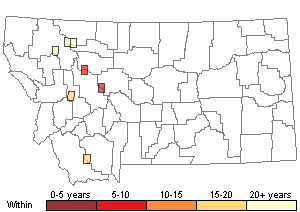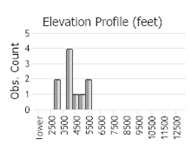View in other NatureServe Network Field Guides
NatureServe
Montana
Utah
Wyoming
Idaho
Wisconsin
British Columbia
South Carolina
Yukon
California
New York
A Diatom - Gomphoneis septa
General Description
Morphological Category – Asymmetric biraphid
Valves lanceolate-clavate; headpole rounded and slightly protracted; footpole narrow, rounded. Valve tapers gently towards the headpole, more strongly towards the footpole, especially in shorter specimens.
Raphe undulate and lateral.
Axial Area narrow at the poles, straight, widens at the center to form a small, somewhat rounded central area. A single round
stigma in the central area.
Striae radiate throughout. Longitudinal lines close to axial area; indistinct in some specimens. Apical pore field small.
Size RangeLength 34–90 µm.
Width 11–15 µm.
Striae in 10 µm 11–12 at valve center; 14–16 at the apices.
Stigmata 1.
Useful Link:
Diatom Glossary [Diatoms of North America website]
Diagnostic Characteristics
Valve shape and larger size distinguish
G. septa from
G. eriensis var. variabilis.
Gomphadelpha montana is smaller and more gracile than
G. septa.
Range Comments
Rocky Mountains of Idaho, Montana and Wyoming.
Type Locality
Flathead Lake.
Number of Observations in Montana Diatom Collection Database (Bahls 1968-2019): 78;
Montana: 71
Observations in Montana Natural Heritage Program Database
Number of Observations: 10
(Click on the following maps and charts to see full sized version)
Map Help and Descriptions
Relative Density

Recency



 (Observations spanning multiple months or years are excluded from time charts)
(Observations spanning multiple months or years are excluded from time charts)
Habitat
Lakes, rivers and creeks.
Ecology
Cold, circumneutral waters with low conductivity and nutrients.
Water Chemistry
Conductivity = 539 µS/cm; pH = 8.3; water temperature = 5.6 degrees C; total nitrogen = 0.290 mg/L; total phosphorus = 0.023 mg/L.
Reproductive Characteristics
Diatoms typically reproduce by cell division (mitosis) and occasionally by meiosis—sexual reproduction in which female and male gametes combine to form a specialized zygote called an auxospore. Repeated divisions result in cells of a population becoming progressively smaller and smaller. When cells reach a critically small size, sexual reproduction is initiated, resulting in an auxospore and initial cells that are the largest attainable for the species, after which cell division and size reduction resume (Amato 2010).
Stewardship Responsibility
Threats or Limiting Factors
Climate change and regional warming.
References
- Literature Cited AboveLegend:
 View Online Publication
View Online Publication Amato, A. 2010. Diatom reproductive biology: living in a crystal cage. The International Journal of Plant Reproductive Biology 2(1): 1-10.
Amato, A. 2010. Diatom reproductive biology: living in a crystal cage. The International Journal of Plant Reproductive Biology 2(1): 1-10.
- Additional ReferencesLegend:
 View Online Publication
View Online Publication
Do you know of a citation we're missing? Abarca, N., R. Stancheva, O. Skibbe, K. Schimani, W.H. Kusber, J. Zimmermann and R. Jahn. 2023. Gomphadelpha (Bacillariophyceae) – a new genus name for taxa formerly subsumed in the Gomphoneis herculeana group. Nova Hedwigia 117:213–254.
Abarca, N., R. Stancheva, O. Skibbe, K. Schimani, W.H. Kusber, J. Zimmermann and R. Jahn. 2023. Gomphadelpha (Bacillariophyceae) – a new genus name for taxa formerly subsumed in the Gomphoneis herculeana group. Nova Hedwigia 117:213–254. Bahls, Loren. 2023. Diatoms of Montana and western North America: Catalog and atlas of species in the Montana diatom collection Volume 2. The Academy of Natural Sciences of Philadelphia Special Publication 27. 600pp.
Bahls, Loren. 2023. Diatoms of Montana and western North America: Catalog and atlas of species in the Montana diatom collection Volume 2. The Academy of Natural Sciences of Philadelphia Special Publication 27. 600pp. Kociolek, J.P., E.F. Stoermer and L.L. Bahls. 1986. Observations on North America Gomphoneis III. Gomphoneis septa comb. nov. Canadian Journal of Biology 64(11):2764-2768.
Kociolek, J.P., E.F. Stoermer and L.L. Bahls. 1986. Observations on North America Gomphoneis III. Gomphoneis septa comb. nov. Canadian Journal of Biology 64(11):2764-2768. Moghadam, F. 1969. An ecological and systematic study of the planktonic diatom communities in Flathead Lake, Montana. Proceedings of the Academy of Natural Sciences of Philadelphia 121:153-228.
Moghadam, F. 1969. An ecological and systematic study of the planktonic diatom communities in Flathead Lake, Montana. Proceedings of the Academy of Natural Sciences of Philadelphia 121:153-228. Patrick, R.M. and Reimer, C.W. 1975. The Diatoms of the United States, exclusive of Alaska and Hawaii, V. 2. Monographs of the Academy of Natural Sciences of Philadelphia 13.
Patrick, R.M. and Reimer, C.W. 1975. The Diatoms of the United States, exclusive of Alaska and Hawaii, V. 2. Monographs of the Academy of Natural Sciences of Philadelphia 13.
- Web Search Engines for Articles on "A Diatom"





